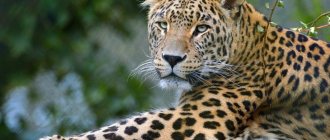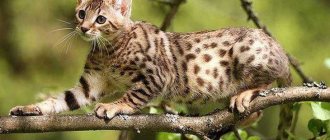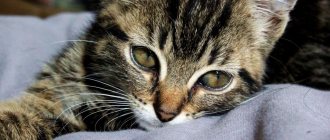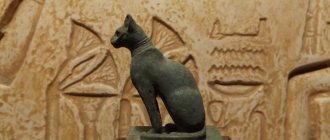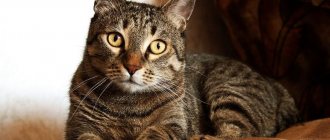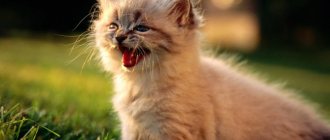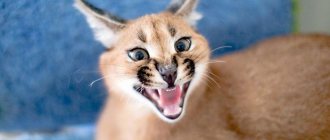One of the rarest representatives of the cat family is an animal called the clouded leopard. Let's take a look at the photo of the clouded leopard and admire this truly majestic predator.
The clouded leopard's habitat is tropical dry forests. This species is considered endangered, so predators are protected by law in most of its range. But in Thailand and India, few people follow these laws.
Clouded leopard (Neofelis nebulosa).
Today there are about 250 clouded leopards in zoos, and there are about 10,000 in the wild.
Appearance of the animal
In length, male clouded leopards reach 80-105 centimeters, and females - 68-95 centimeters. To this figure it is also worth adding the length of the tail - 60-90 centimeters. The height at the withers is about 50-55 centimeters. Clouded leopards weigh 11-23 kilograms.
This wild cat has luxurious fur.
The animal has short and wide limbs, with the hind legs being longer than the front ones. The head shape is elongated. The fangs are large.
The eyes are yellow. The skin is dark ocher or dark gray with dark gray or black spots. The spots are large, their shape is not the same.
There are also spots on the head. Black stripes stretch from the corners of the eyes to the mouth. The spots along the spine are elongated. There are also spots on the stomach and legs. The tail is surrounded by black half rings.
Clouded leopards are night hunters.
What does a clouded leopard eat?
The clouded leopard is a carnivore whose diet consists of jungle primates and birds. The cat catches and kills its prey only with a powerful blow of its paw, being high above the ground, in the branches of trees. Natural camouflage allows the predator to sneak up close to the prey, remaining unnoticed against the background of foliage.
The clouded leopard hunts not only in trees. On land, goats, pigs and deer can be its victims. No matter how heavy the prey, the predator easily and without fear of falling jumps onto a tree and only there begins to eat. With game in its mouth, the clouded leopard is able to maintain its balance while standing on its two hind legs.
Very often, deforestation forces the predator to attack livestock. Although he usually tries to avoid places inhabited by people. Not only the clouded leopard inhabits the expanses of the jungle, tigers and panthers, which are stronger and larger, also live there. Therefore, in the event of a collision, the clouded leopard prefers to leave, since it knows that it will lose. For a very long time it was thought that the predator was exclusively nocturnal, but now the inconsistency of the bottom statement has been reliably documented. He hunts not only at sunset, when his potential prey is sleeping, but also during the day.
Reproduction and lifespan
During the day the predator prefers to rest.
Clouded leopards reach sexual maturity at two years of age. The mating season lasts from December to March, during which time the level of aggression in males increases extremely.
The pregnancy process lasts 3 months. A litter consists of 2-5 babies, but most often there are three of them. The weight of newborns is 160-260 grams. The kids are completely helpless and blind. The color of the kittens is uniform, there are no spots, they begin to appear only at 6 months.
10 days after birth, leopards open their eyes. The female feeds the babies with milk for 3 months. And already 10 months after birth, the young begin an independent life. Females bear offspring annually.
In the wild, the lifespan of clouded leopards is about 11 years; in zoos, members of the family live somewhat longer, with a maximum age of 17 years.
This leopard preys on a variety of animals.
Clouded leopard video
In the qualifying generic list, the animal does not belong to any genus. As a species with similar features, it was included in the same genus with the marbled feline and the tiger. The clouded leopard is a kind of “transition” from the impressive size of predators and smaller cats living in nature. And more recently, this amazing cat is classified in the same genus as the tiger.
The jungle is the home of the clouded leopard, which stretches from lowlands to mountain passes. The maximum point where the predator was encountered was 2.5 kilometers above sea level. It has even been seen in the Tibetan mountain ranges. Being an excellent tree climber, the clouded leopard actually does not leave the upper tiers of the jungle. They serve him not only as a place to sleep and rest, but also as an ambush in which the animal awaits its prey.
This animal is very difficult to see. He lives in places that are practically inaccessible to humans. The color of the “fur coat” allows the predator to become almost invisible in the lush greenery of the jungle. The clouded leopard is an agile predator capable of moving along branches in the upper tiers of the jungle. The danger that awaits the cat is the intensive destruction of the forests of China and southeast Asia, the animal’s natural habitat.
What threats to the numbers of these predators currently exist?
The main threat to the population is the loss of the natural environment. The blame for this lies with people, since they are actively deforesting. Poaching also causes damage to the population. Clouded leopards are hunted for their magnificent skins, claws and teeth.
Leopard meat is also used in traditional Asian medicine as a substitute for tiger meat. In addition, live clouded leopards are highly valuable due to their beautiful appearance.
All these factors have the most negative impact on the population size. Today, measures to preserve these unique animals are being taken, but they are not enough.
If you find an error, please select a piece of text and press Ctrl+Enter.
Nutrition
The clouded leopard is a 100% predator. Its diet includes both small and fairly large mammals. These may include:
- Birds and fish;
- Monkey;
- Deer;
- Rodents;
Favorite prey for this species are: Argus pheasant, wild boar, Javan pangolin and Himalayan civet. These animals kill their prey with one bite to the neck.
Clouded leopard cub
Clouded leopard and people
The man began to sound the alarm when the clouded leopard was on the verge of extinction. Having no prohibitions, in the last century, people did not hesitate to exterminate the animal, solely because of its elegant skin. Poachers still trade, despising the laws, with hats made from the fur of a predator.
People noticed the likelihood of extinction of the species when they came to its sought-after lands for valuable wood raw materials. Almost the entire habitat was destroyed, including the most inaccessible corners. The clouded leopard never inspired fear among the aborigines, like the tiger, but this did not stop it from being destroyed, since occasionally poultry fell into its paws.
Leopard distribution
— Advertising —
Leopards are common in Africa and Asia, in the north of the Caucasus Mountains and in the Amur taiga. For life they choose savannas, mixed forests and mountain slopes.
In general, these predators adapt well to any environment. So, on the African continent they live in jungles, savannas, semi-deserts and mountains. But coniferous and dense tropical and subtropical mixed forests of Asia are also becoming an acceptable habitat for them.
Life in captivity
A spacious enclosure is being prepared for the Asian leopard cat, which has not been raised by humans and has retained its wild habits. Its height is at least 2 m, length 4–5 m. The metal mesh roof is half covered with rainproof material. Two dens are arranged under it so that the animal can choose where to be. They are made in the shape of a sleeve or a house. Wooden parts are used for manufacturing.
Bushes and palm trees are planted inside the enclosure. It is better to equip a pond with a fountain in the center, decorating it with large shellfish shells. 5–8 shelves and bridges are attached to the sides of the enclosure at a height of 0.3–0.6 m from each other. One bed should be fully illuminated by the sun. Sawn logs are installed at an angle or placed on the floor. They add an imitation of rocky terrain and one or two ladders. Covered litter trays are installed in all corners of the enclosure so that the animal can mark its territory.
For physical health, savages organize hunting with feeding of live prey. To do this, cover the side walls of the enclosure with triplex at a height of up to 35 cm from the floor and install a door. They release a rodent. The cat will not only run around to its heart's content, but will also receive moral pleasure.
When keeping one animal at home, at least 6 hours of play time is required daily. Otherwise, boredom will cause your pet’s behavior to deteriorate. It is ideal to foster two Asian leopard cat . This is the best way to keep them active and occupied. Even constantly adding new toys will not cope with this task. If good conditions are created for the animals, the life expectancy will be 12–14 years.
It is better to start the vaccination schedule at 3.5 months so that the kitten is sufficiently old and strong. At this age, his teeth are fully formed. Leopard cats do not carry diseases that are dangerous to humans. However, they are predisposed to the immunodeficiency virus (VIP). Having become infected from domestic animals, spotted inhabitants of the tropics quickly die from the disease. Due to genetic characteristics, their body is powerless against this infection.
The Asian leopard is for those who do not want an interior cat, but an interesting creature. You need to play with her a lot, come up with puzzles, train and communicate. Always nearby and wants to know what you are doing. You will have to adapt to this cat and change your lifestyle. And you need to be prepared for this.
NatalySeed
https://irecommend.ru/content/bengal-f1-slozhnaya-poroda-dlya-uvlechennykh-lyudei
The necessary conditions
In captivity, the Asian leopard cat is kept warm. Optimal air humidity is 75%. This animal is from tropical latitudes, where at night it is not lower than +15°C. Heating the house or shelves partially solves the problem, but in the cold season the animal is moved from the enclosure indoors. Cages measuring 118x78 cm are installed in a bright, spacious room. They are covered on top with blankets filled with padding polyester. A closed toilet and a scratching post are placed nearby.
Wild leopard cat loves to watch from above
In nature, a wild leopard cat has several secluded places in its territory. It is advisable to make the floor in the room from a smooth and waterproof material so that regular cleaning is convenient. Complexes with climbing arms, hanging balls, and squeaker mice will entertain your spotted pet. But a wild cat will be active only with the participation of the owner in its games.
Video: communication between a tamed kitten and a person
Adult animals are fed once or twice a day. They give you a raw egg, a chicken carcass with feathers and entrails. A delicacy is live quails and mice. Pieces of beef containing tendons add variety to the menu. Premium wet canned meats will do. Amount of food - up to 250 g per day.
The pet is weighed regularly. If body weight does not increase and the cat runs a lot during the day, then weekly daily fasting is not necessary. It is enough to reduce the portion by half or give fish that day.
Communication and perception
Photo: Kate Ryan
Clouded leopards, like lions, tigers and other big cats, cannot purr . However, their range of vocalizations is very wide and includes: meows, hisses, growls, groans and snorts. When two individuals approach each other, they communicate using an acoustic communication channel. When in a friendly mood, they make quiet, low-frequency snorting sounds. Clouded leopards, tigers, snow leopards and jaguars are the only cats that use this type of vocalization.
Sometimes they emit a drawn-out moaning call, clearly distinguishable over long distances . This is a warning sign for other cats to stay away from their territory, and perhaps a call to mate.
Like other felines, clouded leopards have keen eyesight, sense of smell and hearing. They mark their home range by marking their territory using urine, scent glands, and scratching trees.
Behavior
The clouded leopard hunts both day and night. It tracks its prey from the ground, although it is capable of jumping on it from overhanging branches.
The predator has well-developed vision. He sees perfectly in the twilight. At night, it is not only its vision that helps it navigate through the trees, but also its tail and wide feet. With their help, he balances, maintaining balance. Every day, in search of prey, the animal covers a distance of one to two kilometers.
In addition, the predator swims well. This is how he differs from ordinary cats. Researchers suggest that thanks to the ability to cross expanses of water, these representatives of cats settled on small islands located between Vietnam and Borneo.
Observing an animal in its natural environment is quite difficult. It is afraid of people. Sometimes conclusions about the predator are made from interviews with local residents. Thus, it was found that representatives of cats living in Malaysia travel on the ground. They walk along paths and roads. They only rest on trees. Residents of Nepal say approximately the same thing.
Features of the life of leopards in the wild
The distribution range of this animal is wider than that of other large cats. They inhabit forest-steppe and forest areas, mountainous areas and savannas of Africa, Asia (eastern and southern), Primorsky Krai, and the Arabian Peninsula. Occasionally, leopards can be found in the North Caucasus. There are areas where this animal is no longer found. There is a tendency for its habitat to gradually decrease.
Leopards are animals that can adapt to life in any geographical area: mountains, tropical forests, plains, semi-deserts and savannas. The area of territory occupied by one spotted cat is 10-400 square meters. km. The territorial areas of males and females may coincide, however, if representatives of the same sex enter the same territory, a fierce battle necessarily occurs between them, and even ends in death.
A leopard does not often attack a person, but in a wounded state it will certainly defend itself. Among these animals there are cannibals, mostly old, wounded, sick - unable to hunt fully.
Leopards are animals that lead a predominantly solitary lifestyle. During the day they sleep and take leisurely walks around the territory of their site. Hunting is carried out mainly at night. Females with kittens hunt at any time of the day.
This beast makes its lair in secluded places - in caves, in crevices, under the roots of trees. Leopards living in the southern regions breed throughout the year, while individuals from the Far East breed only in late autumn. The duration of pregnancy is three months. Usually 1-3 babies are born. After two and a half years, young individuals reach full growth and become sexually mature.
general description
The weight of an adult leopard is quite impressive. The physique is flexible and elongated. Slender, strong paws have very sharp curved claws about 5.5 cm long. The not very fluffy fur is thick and close-fitting. The fur of animals living in harsher climates becomes longer and duller in color in winter.
The color of the animal is the envy of the place where the leopard lives. Those living in the northern regions have a bright red or light yellow coat color. In African leopards it is reddish-brown or yellowish. In addition to the main color, the leopard has small black or brownish spots on its body. Moreover, each individual has its own individual arrangement and shape of the pattern. The spots can be either circular or solid. Asian representatives have larger ones, and African representatives have smaller ones.
You may be interested in:Bird with a beautiful tail: name with photo, description, habitat
Among leopards there are melanists, often called black panthers. Most of them live on the Malay Peninsula and on the island of Java, with slightly less found in Africa and India. Often black individuals are born together with spotted ones in the same litter. Information on how much a leopard weighs is given below in the article.
Characteristics
This animal is a fairly large cat. The weight of an adult leopard is 32-75 kg. There are also larger individuals (up to 90 kg). The body reaches 90-180 cm in length (not counting the tail). Height – up to 45-90 centimeters. The tail has a length of 75-110 cm.
The massive skull has an elongated structure, slightly low. The nasal bones narrow at the back, the zygomatic arches are not very widely spaced. Like most cats, a leopard has 30 teeth in its mouth. Each jaw has 6 incisors and 2 canines. The rather long tongue is equipped with tubercles that help the animal wash itself and separate meat from the bone.
The size and body weight of leopards are completely different and depend on their habitats. The largest are the individuals that inhabit more open spaces, while their counterparts living in forest areas are smaller and lighter. Females are smaller than males, and their weight is 32-65 kg. Males weigh from 60 to 75 kg.
Content Features
A clouded leopard as a pet is very rare. An active animal requires a spacious enclosure, well equipped and occupying a fairly large area. Reproduction in captivity occurs very rarely.
Smoky individuals are purchased from specialized nurseries that breed predators in captivity. The price for a cute wild cat starts at $25 thousand. In addition, it will take an impressive amount of money to feed her pussy every day, because she will not eat anything other than meat and fish dishes.
The purchase of a clouded leopard pays off only if it is placed in a zoo, where the price of a ticket and the huge number of visitors make it possible to provide the wild predator with everything it needs.
Status and protection of animals
You may be interested in: The largest snake on Earth is the reticulated python: description, where it lives, what it eats, size and weight
We’ll talk about how much a leopard weighs a little later, but for now a little about the problems associated with this animal.
Today, 5 subspecies are under threat of extinction. The main reason for the population decline is changes in the natural habitat, poaching and a decrease in food resources.
You may be interested in:Spanish lynx: features of the species
It should be noted that the number of Far Eastern leopards as of 2007 was approximately 34 individuals. The good news is that by the beginning of 2015 their number had increased to approximately 57. However, there are subspecies listed in the Red Book of Russia and the IUCN.
Did you know?
- The oldest individual in captivity lived to be 17 years old, although their average lifespan is usually 11 years.
- It is estimated that the entire clouded leopard population consists of only 10,000 individuals .
- The natives of Taiwan believe that the clouded leopard is their spiritual ancestor, who brought them to their homeland.
- Clouded leopards are sacred to some indigenous peoples of Southeast Asia. Malaysians call them "tree cats" due to their preference for resting on tree branches. The Chinese call them "mint leopards" because their spots remind them of mint leaves. Unfortunately, none of these names have helped protect these wild cats from poachers.
- The clouded leopard's fur pattern is reminiscent of the marbled cat, which is also found in southeastern Asia.
Cat character
The Ocicat is a social and active animal. They love to be the center of attention. People who come to visit will be watched with interest. They will immediately hide in a corner somewhere (especially cats), but then, having gotten used to it, they will go get to know everyone. But they will not go into the arms of strangers.
This is a very curious animal, interested in everything. The cat will follow you everywhere: to the kitchen, to the bathroom (even if it doesn’t like water).
At the same time, look at all actions with a perplexed and questioning gaze. He will also be interested in testing the vacuum cleaner he is interested in to understand: what can it be used for?
If the cat is hungry, he will definitely climb onto the highest shelf where the bags of food are hidden and will definitely bite everything. If an animal likes some kind of toy, for example, a magnet on the refrigerator, he will definitely get it, even if he falls out of there along with the dishes on top.
The Ocicat is a very active, cheerful cat. He loves to play. Therefore, if there are small children or other animals in the house, pranks will be in full swing! Make sure you have enough toys so that the interior is not damaged.
Ocicats are highly intelligent and quickly learn new tricks and commands, especially if the process takes place in the form of a game.
You should not force an animal - nothing will come of it. This cat tolerates moving quite calmly, but cannot stand confined spaces. It is better to place him in a spacious open carrier or sit him next to you, fastening him with a leash.
What speed does a leopard develop in km/h?
The maximum speed that a predator can reach is 50 kilometers per hour. Compared to the fastest animal (the cheetah), this is a relatively modest result. The speed of the latter is 110 kilometers per hour or more.
It should be noted that leopards do not waste their energy. They do not pursue their prey at high speeds, but simply follow it and lure it. However, sometimes they have to use their agility and dexterity to escape their main enemies, such as tigers, lions and people.
Common Leopard Species
For the leopard, the following subspecies are distinguished depending on the regions of their habitat:
- African leopard (Panthera pardus pardus) in Africa
- Indochinese leopard (Panthera pardus delacouri) in Indochina
- Javan leopard (Panthera pardus melas) on acute Java
- Indian leopard (Panthera pardus fusca) in India, southeast Pakistan, Nepal
- Ceylon leopard (Panthera pardus kotiya) in Ceylon
- North China leopard (Panthera pardus japonensis) in China
- Far Eastern leopard (Panthera pardus orientalis) in the Far East, northern China, Korea
- Persian leopard (Panthera pardus saxicolor) in Western Asia and the Caucasus
- South Arabian leopard (Panthera pardus nimr) on the Arabian Peninsula.
